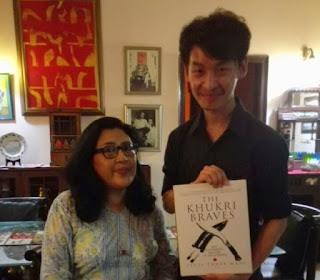Anmol Mukhia for IG
Book Review on Mani, Jyoti Thapa (2015), “The Khukri Braves: The illustrated history of Gorkhas”, Rupa Publication, New Delhi, Page 407.
The author (Jyoti Thapa Mani) has illustrated the book entitled “The Khukri Braves: The illustrated history of Gorkhas,” not only from the pictorial representation but also from the rich encyclopaedia of Gorkha histories. The book is divided into six parts with its sub chapters, each dealing with the Gorkha in association with his formation, struggle for unification and engagements in service, which makes unique in understanding the Gorkha community. The author says “But it must not be forgotten that the Gorkha name was earned by the sweat, blood and sacrifices of millions over centuries.” What makes this book unique in the relation to Gorkha is ‘double-b’ as pride, which I understood according to author, as the transformation of bravery to brand. Gorkha has become a brand as Trax Gurkha, Gurkha Cigar, Khukri Rum, and Khukri known all over the world.
Most important part of this book is the illustration of Gorkha from three phases. Firstly, the 19th Century shivetis Baba Gorakhnath whose influence are found from Gorkha district in Gorakhpur (Nepal) to Gorakpur in Uttar Pradesh (India) and the followers or the people living in the surrounding was known as Gorkhas. Secondly, mighty Shah Dynasty ruler Prithvi Narayan Shah was successful in unifying the Gorkha in 1742, where he himself claimed as the king of Magar before dying. During his rule, Gorkha also worship lord Bhairav and in 1785 king Prithvi Narayan Shah raised a company in his army called Bhairav Dal. However historian believe in the genealogy of Raiputs from Parmar Rajputs of Narsinghgarh state in Malwa and Chittore Rajasthan, and the Shah or Sahi were given the title of respect to the warrior. Thirdly, famous Gorkha army encountered by the British in 1815 with the birth of Nurseerree Battalions and the Sirmour Battalion drives them to fight for the foreign nation.
In relation to the Khukri Braves, the book has also justified the Gorka community in association with his Khukri, where majority of Gorkha worship Kali which is also known for Kal Yug. Again the Kal Yug is known for the end days where ‘the evil man kills the evil man’. Therefore the slogan started as Jai Mahakali! Ayo Ayo Gorkhali, which inspired the Gorkha soldiers in different fields as an inspiration during the various wars. Thus the Gorkhali with his khukri became associated with his pride.
However, the book also shows the misrepresentation of Durga Malla statue as the khukri soldiers with his horse, when the author shows the history of Malla as Gorkha intelligence. Also khukri was used for the foot soldiers and not the horse warriors. There are many errors in the Gorkha history with multiple gaps and the book The Khukri Braves are successful in linking the gaps with logical illustration. This book shows Gorkha association not only with the Hindu religion but also with Buddhism and Christians. The final impressive hypothetical assumption made by the author is the Buddha antique statue at the Nepal National Museum, where she shows the elongated ear lobes indicate that he had grown up in a culture which wore circular discs or tubes in the ear holes.
Book Review on Mani, Jyoti Thapa (2015), “The Khukri Braves: The illustrated history of Gorkhas”, Rupa Publication, New Delhi, Page 407.
The author (Jyoti Thapa Mani) has illustrated the book entitled “The Khukri Braves: The illustrated history of Gorkhas,” not only from the pictorial representation but also from the rich encyclopaedia of Gorkha histories. The book is divided into six parts with its sub chapters, each dealing with the Gorkha in association with his formation, struggle for unification and engagements in service, which makes unique in understanding the Gorkha community. The author says “But it must not be forgotten that the Gorkha name was earned by the sweat, blood and sacrifices of millions over centuries.” What makes this book unique in the relation to Gorkha is ‘double-b’ as pride, which I understood according to author, as the transformation of bravery to brand. Gorkha has become a brand as Trax Gurkha, Gurkha Cigar, Khukri Rum, and Khukri known all over the world.
 |
| Anmol Mukhia with Jyoti Thapa Mani |
In relation to the Khukri Braves, the book has also justified the Gorka community in association with his Khukri, where majority of Gorkha worship Kali which is also known for Kal Yug. Again the Kal Yug is known for the end days where ‘the evil man kills the evil man’. Therefore the slogan started as Jai Mahakali! Ayo Ayo Gorkhali, which inspired the Gorkha soldiers in different fields as an inspiration during the various wars. Thus the Gorkhali with his khukri became associated with his pride.
However, the book also shows the misrepresentation of Durga Malla statue as the khukri soldiers with his horse, when the author shows the history of Malla as Gorkha intelligence. Also khukri was used for the foot soldiers and not the horse warriors. There are many errors in the Gorkha history with multiple gaps and the book The Khukri Braves are successful in linking the gaps with logical illustration. This book shows Gorkha association not only with the Hindu religion but also with Buddhism and Christians. The final impressive hypothetical assumption made by the author is the Buddha antique statue at the Nepal National Museum, where she shows the elongated ear lobes indicate that he had grown up in a culture which wore circular discs or tubes in the ear holes.


.jpg)



Post a Comment